Galleon Trade Foods That Shaped Filipino Cuisine
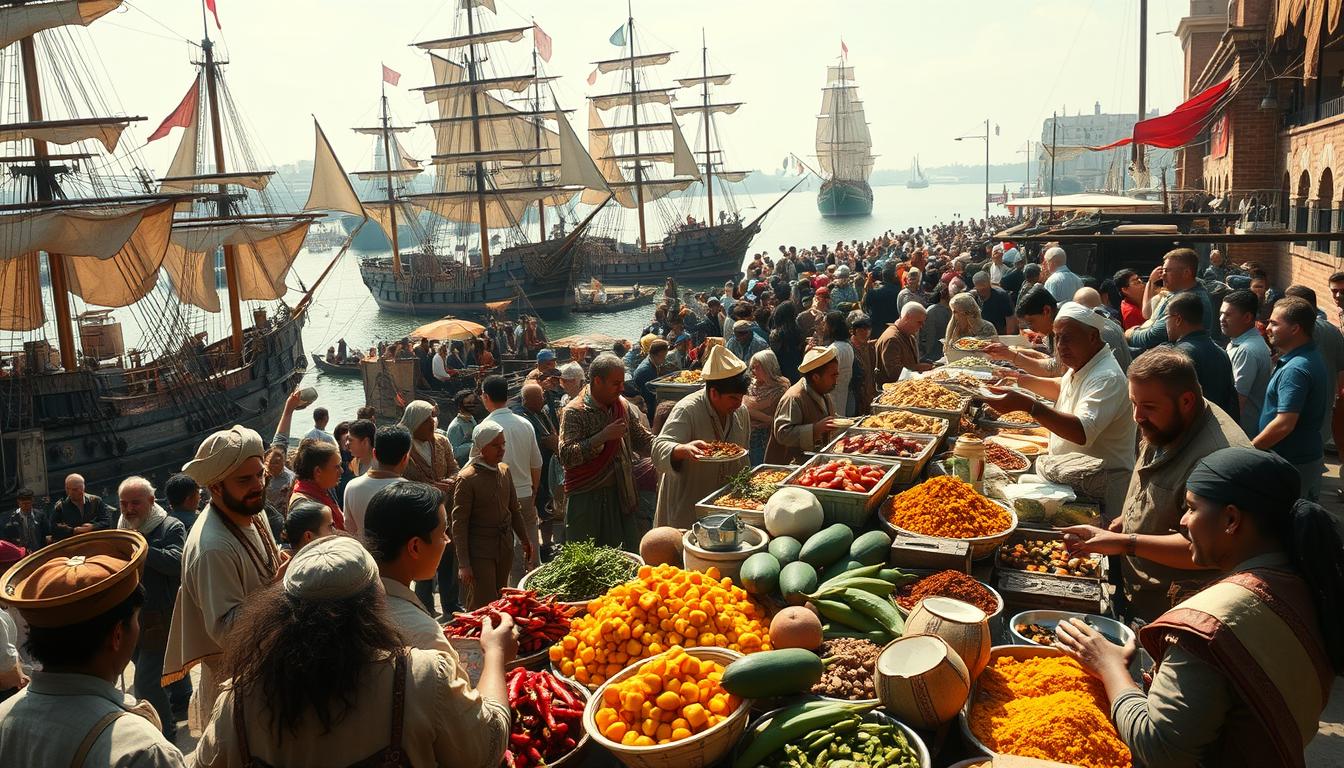
Imagine a table filled with vibrant dishes—savory stews, sweet desserts, and hearty rice porridge. Each bite tells a story of crossroads, where ancient traditions met flavors from across oceans. Centuries ago, bustling trade routes connected distant lands, bringing ingredients like tomatoes, corn, and chocolate to Philippine shores. These treasures didn’t just spice up meals—they rewrote an entire culinary legacy.
Long before modern globalization, local cooks blended foreign ingredients with native techniques. Think of champorado, a chocolate-rice porridge born from Mexican cacao and Filipino creativity. Or lumpia, crispy rolls that evolved through Chinese and Spanish inspirations. This wasn’t just mixing flavors—it was a silent revolution on plates, preserving identity while embracing change.
From smoky adobo to festive paellas, every dish became a bridge between worlds. Communities gathered, shared recipes, and turned foreign spices into homegrown staples. Today, these meals aren’t just food—they’re living memories of resilience and innovation. As we explore this journey, you’ll see how global exchange shaped a cuisine that’s uniquely rooted yet endlessly adaptable.
Key Takeaways
- Historic trade routes introduced ingredients like tomatoes, corn, and chocolate to local cooking.
- Dishes like champorado and lumpia showcase creative adaptations of foreign influences.
- Culinary fusion preserved cultural identity while integrating global flavors.
- Communal meals became bridges connecting indigenous traditions with overseas techniques.
- Modern Filipino food reflects centuries of innovation and cross-cultural resilience.
Introduction to Filipino Culinary Heritage
What does it mean to taste history? In the Philippines, every meal answers this question. The nation’s food carries whispers of ancient tribes, colonial encounters, and family bonds simmered over generations. Picture a grandmother’s hands shaping rice dough for bibingka, her movements echoing techniques older than written records.
Local culture thrives in shared meals. Families gather around steaming pots of sinigang, where sour tamarind meets fresh seafood—a balance perfected through time. “Food isn’t just eaten here; it’s lived,” shares Maria Santos, a Cebu-based chef. “Recipes are love letters from our ancestors.”
Three elements define this heritage:
- Layered roots: Indigenous ingredients like coconut and ginger blend with Spanish olive oil or Chinese soy sauce.
- Communal spirit: Festive fiestas and daily merienda snacks turn eating into collective joy.
- Adaptive techniques: From clay pot cooking to modern fusion, methods evolve while honoring tradition.
Through wars, migrations, and festivals, people have preserved their identity one bite at a time. This article unpacks how centuries of exchange created a culture where every dish tells a story—and invites you to the table.
Historical Overview: From Pre-Colonial to Colonial Eras
Long before foreign ships dotted the horizon, the archipelago thrived with self-sufficient food systems. Early communities relied on root crops like taro and yams, while coastal villages harvested seafood using woven traps. Rice, though prized for rituals, wasn’t yet the daily staple—it symbolized status and spiritual connection.

By the 16th century, life revolved around local abundance. “We cooked what the land gave us—coconut milk for richness, wild herbs for healing,” notes anthropologist Dr. Lila Ramos. Clay pots simmered over open fires, preserving flavors without foreign spices. Fermented fish sauce (bagoong) and rice wine cemented communal bonds.
Everything shifted when global trade routes reached these shores. The Manila-Acapulco voyages introduced:
- New World crops (tomatoes, corn)
- Preservation techniques (vinegar stews)
- Cooking tools (metal cauldrons)
Over time, these elements blended with native practices. What began as survival strategies became a layered culinary history. The galleon trade didn’t just transport goods—it rewrote recipes, turning simple meals into bridges between continents.
Today’s cuisine carries this duality: earthy flavors rooted in the archipelago, amplified by centuries of global influence. Each bite whispers stories of adaptation—a testament to resilience through changing years.
Native Food Traditions and Ingredients
The Philippine archipelago’s rich soil and waters have always been a pantry of possibilities. Generations of islanders transformed wild greens, tropical fruits, and ocean harvests into meals that fed both body and spirit. At its core, this food culture celebrates what grows freely under the sun.
Local Staples and Indigenous Produce
Three elements defined early ingredients: versatility, accessibility, and flavor. Rice thrived in terraced fields, becoming the backbone of daily meals. Coconut palms offered milk for stews, oil for frying, and flesh for desserts. Wild herbs like lemongrass added brightness to broths without overpowering natural tastes.
| Ingredient | Primary Use | Region |
|---|---|---|
| Sticky Rice | Festive desserts | Luzon highlands |
| Coconut Vinegar | Meat preservation | Visayas islands |
| Siling Labuyo | Spice blends | Bicol region |
Traditional Cooking Methods of the Archipelago
Early cooking relied on fire and ingenuity. Clay pots simmered soups slowly over coals, while bamboo tubes steamed rice to perfection. “We didn’t need fancy tools,” says historian Louella Alix. “Banana leaves became plates, and coconut shells turned into cups.”
Three techniques stood out:
- Kilaw: Raw fish cured in citrus or vinegar
- Sugba: Meats smoked over fruitwood
- Paksiw: Vinegar-based stews that preserved leftovers
These methods required patience but rewarded families with layered flavors. Even today, modern kitchens honor these traditions—proof that simplicity often yields the deepest connections to heritage.
The Galleon Trade Foods That Shaped Filipino Cuisine
Sailing ships carried more than spices and silk across oceans—they delivered flavors that transformed kitchens. When vessels from Mexico docked in Manila Bay, crates brimmed with plants once unknown in the islands. These arrivals sparked a quiet revolution in local cooking.
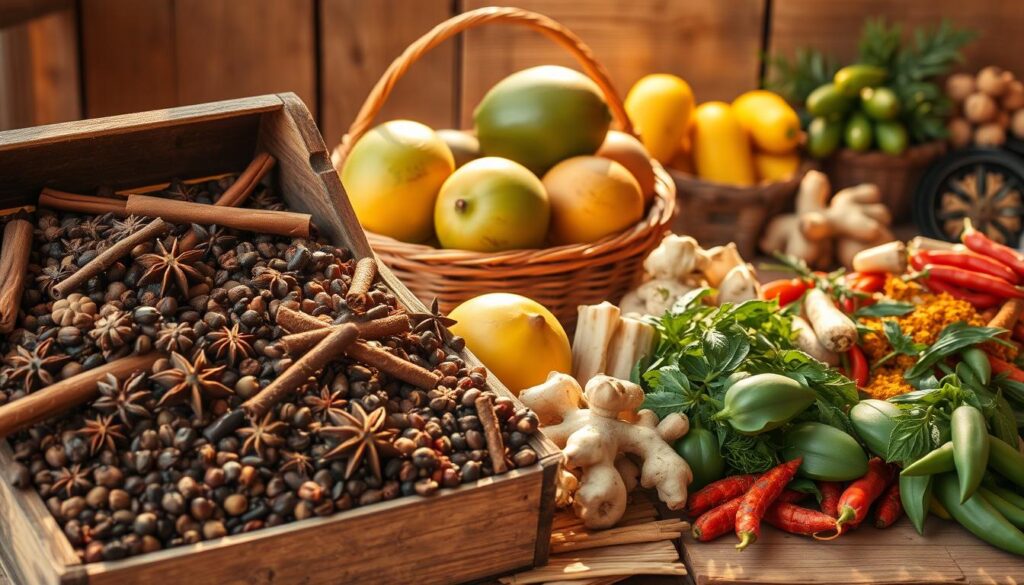
Key Ingredients Introduced by the Trade
New World crops like tomatoes, avocado, and papaya arrived through maritime routes. Resourceful cooks embraced these additions, weaving them into daily meals. Chayote became sayote, stewed with shrimp paste. Cacao beans turned into rich tablea tablets for frothy chocolate drinks.
| Ingredient | Local Adaptation | Modern Use |
|---|---|---|
| Tomatoes | Sinigang sour base | Stews, sauces |
| Cassava | Pounded into desserts | Cassava cake |
| Guava | Sweet jams | Pastry fillings |
Cultural Exchange and Culinary Integration
Foreign elements didn’t replace traditions—they enhanced them. Spanish vinegar preservation methods merged with native kilaw techniques. “We took what worked and made it ours,” says chef Roland Lauengto. “Our dishes became passports to shared histories.”
Chili peppers from the Americas spiced up Bicol’s coconut milk stews. Mexican tamales inspired suman rice cakes wrapped in banana leaves. Each adaptation reflected practical needs and creative flair, binding global influence to local identity.
Today, these ingredients feel inherently Filipino. Their journey from ship holds to family tables reveals how cuisine evolves through openness—one simmering pot at a time.
Spanish Influence on Filipino Cuisine
Spanish flavors simmered into local kitchens through techniques that reshaped daily meals. While olive oil and saffron arrived via trade, resourceful cooks blended them with native ingredients. This fusion birthed dishes balancing European methods with tropical flair.
Evolution of Adobo and Pochero
Spanish adobar (marinating) inspired the iconic adobo. But instead of wine, cooks used coconut vinegar and soy sauce. “The acidity preserved pork in humid climates while adding tang,” explains chef Teresa Cruz. Pochero stews swapped Spanish chorizo for saba bananas, simmering chicken in tomato-based sauce.
| Dish | Spanish Version | Filipino Adaptation |
|---|---|---|
| Adobo | Wine-marinated meats | Vinegar, soy sauce, garlic |
| Pochero | Chickpeas, chorizo | Bananas, sweet potatoes |
Adaptation of Spanish Recipes to Local Tastes
The gisado sauté method became foundational. Garlic and tomatoes replaced Spanish paprika, while vinegar cut through rich broths. Meals once centered on beef shifted to pork—a livestock more suited to local farms.
Three key changes emerged:
- Substituting scarce items (olive oil → coconut oil)
- Extending cooking times for tougher local meats
- Adding chili to balance creamy sauce bases
These tweaks turned colonial recipes into comfort foods, proving innovation thrives at the intersection of tradition and necessity.
Chinese Impact: Noodles, Stir-Frying, and More
The clatter of woks in busy markets tells a story older than written recipes—a tale of culinary adaptation that reshaped kitchens across the islands. Chinese traders brought more than goods; they introduced techniques like stir-frying that became cornerstones of local cooking. This method, using high heat and quick motions, transformed humble ingredients into vibrant dishes bursting with texture.
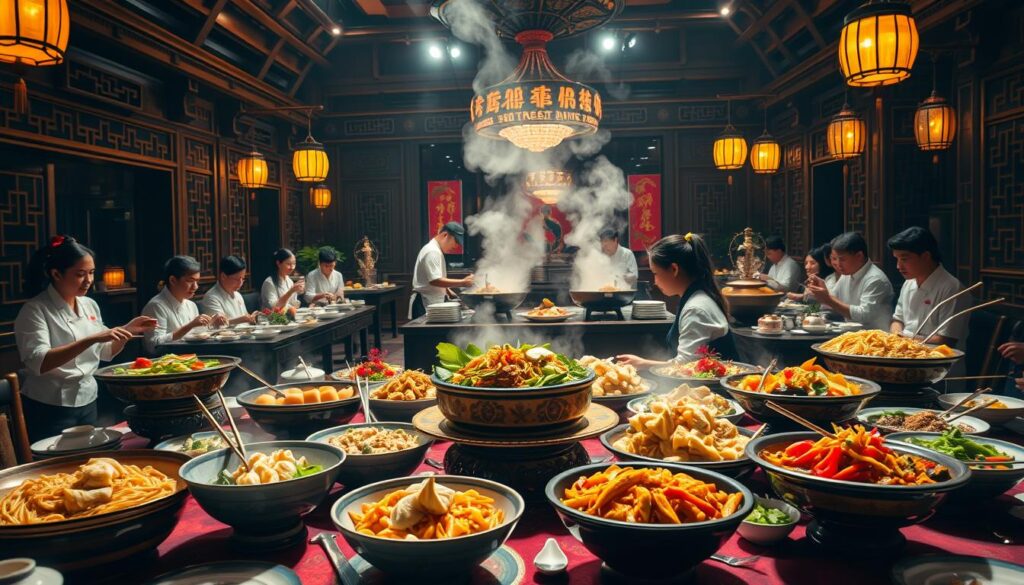
Noodle-based meals like pancit exemplify this fusion. Originating from Fujian traditions, these strands of sustenance evolved into regional specialties. Pancit Malabon piles thick rice noodles with shrimp, oysters, and squid, while Pancit Lucban mixes vermicelli with pork and vegetables. “Noodles symbolize longevity,” explains chef Marco Lim. “They’re now essential at birthdays—proof of how deeply Chinese culture rooted itself here.”
Three key contributions endure:
- Versatile proteins: Fish and shrimp became star ingredients, featured in dishes like ngohiong rolls or soy-glazed lumpia.
- Flavor foundations: Sauces like toyo (soy) and spices like five-star anise added depth without overpowering local palates.
- Staple pairings: Steamed rice balanced rich stir-fries, ensuring meals satisfied both hunger and heritage.
These methods didn’t just alter recipes—they rewired how communities approached food. Clay pots gave way to carbon steel woks (kawali), while markets brimmed with petsay cabbage and toge sprouts. Today, sizzling pans and noodle stalls stand as living monuments to a influence that’s both foreign and familiarly homegrown.
American Influences: Convenience Foods and Breakfast Staples
The sizzle of Spam hitting a hot pan at dawn is a sound many Filipino households know well. American innovations reshaped morning meals through canned goods and quick-prep ingredients that fit bustling modern life. “Sunday mornings meant spamsilog—fried eggs, garlic rice, and that salty-sweet meat,” recalls Manila resident Jessa Morales. “It felt like luxury in a can.”
Canned meat became a pantry staple, especially after WWII shortages. Families adapted recipes to stretch these imports—chopping Spam into omelets or simmering corned beef with tomatoes. Breakfast tables now balanced local rice with foreign flavors:
| Traditional Item | American Addition | Modern Hybrid |
|---|---|---|
| Dried fish | Spam | Spamsilog |
| Coconut vinegar dip | Banana ketchup | Sweet-savory glaze |
| Rice porridge | Evaporated milk | Creamy arroz caldo |
Eggs and milk symbolized this shift toward convenience. Silog dishes (sinangag + itlog) turned fried eggs into quick protein anchors. Meanwhile, evaporated milk sweetened coffee and desserts, replacing labor-intensive coconut pressing.
Sweetness surged too. When tomatoes grew scarce, banana ketchup mixed mashed fruit with sugar and spices—a tangy twist now slathered on burgers and fries. These tweaks didn’t erase tradition; they added shortcuts for faster-paced life.
Today’s cuisine reflects this practical fusion. Canned meat sizzles beside pickled papaya, proving that global food trends can coexist with heritage. As chef Tina Diaz notes: “We took American efficiency and made it taste like home.”
Indo-Malay Impact: Curry, Coconut Milk, and Stews
In the humid kitchens of Mindanao, golden pots bubble with fragrant stews that carry whispers of ancient spice routes. Coconut milk—thick and velvety—forms the backbone of these creations, binding fiery chilies to earthy turmeric. This is where Indo-Malay flavors meet island ingenuity, turning humble ingredients into soul-warming meals.
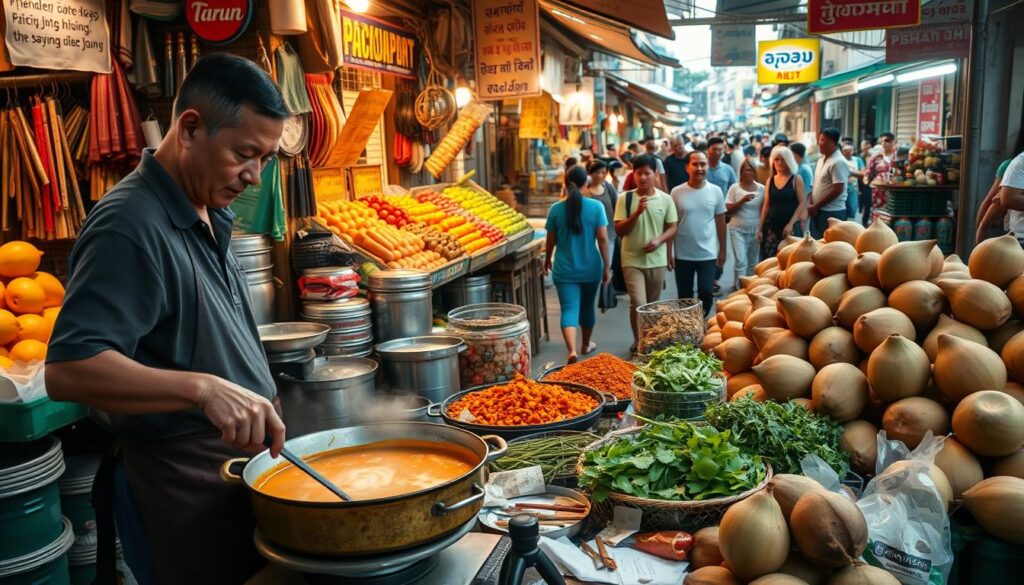
Dishes like laing showcase this fusion. Taro leaves simmered in coconut milk absorb the heat of siling labuyo peppers, creating a taste that’s both bold and comforting. “The magic lies in balancing spice with creaminess,” says Davao-based chef Amina Santos. “Each bite tells of trade winds and shared traditions.”
Three elements define this culinary legacy:
- Versatile coconut: From milk to oil, every part enhances stews and curries.
- Spice harmonies: Ginger, lemongrass, and turmeric merge into complex layers.
- Slow simmering: Time-tested cooking methods deepen flavors naturally.
Even simple meals like ginataang manok (chicken in coconut stew) reveal history. Chilies from Malay traders meet native coconut, while techniques like open-fire cooking preserve ancestral methods. These dishes aren’t just meals—they’re edible bridges connecting centuries of exchange.
Today, the warmth of these flavors endures. Families still gather around pots of coconut milk-laced stews, savoring a taste that’s both timeless and evolving. As smoke curls upward from clay pots, it carries stories of resilience—one simmering spoonful at a time.
Fusion of Flavors: Transforming Borrowed Dishes
The alchemy begins when foreign recipes meet local kitchens—a pinch of tradition here, a dash of reinvention there. Take the humble tamale: once a Mesoamerican staple wrapped in corn husks, it evolved into a rice-based delicacy steamed in banana leaves. Filipino cooks swapped masa for sticky rice flour and added coconut milk, creating a sweeter, denser treat. “Our version isn’t just a dish—it’s a conversation between cultures,” says chef Luis Manalo.
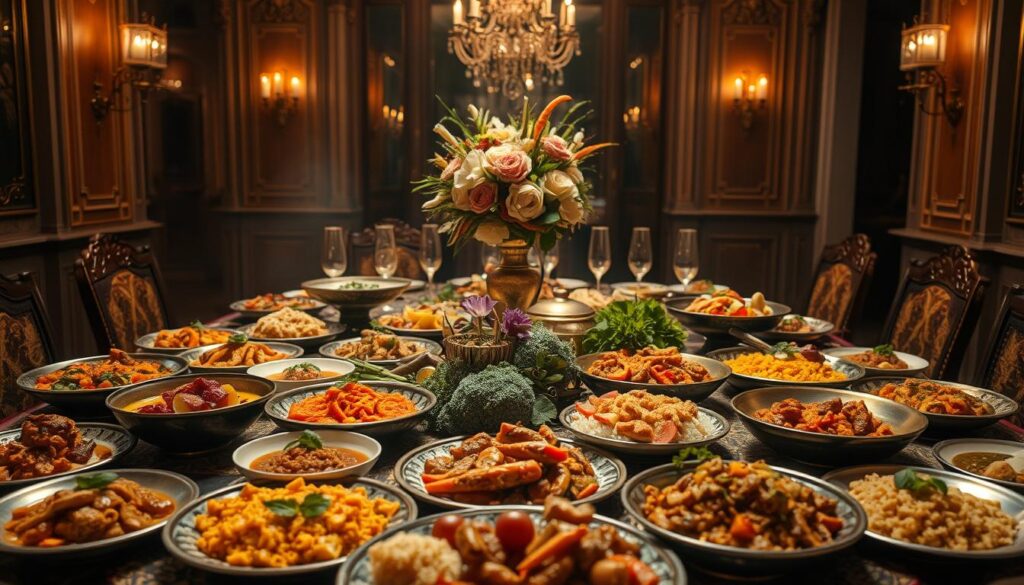
This adaptive method reshaped many dishes like paella. Original Spanish saffron rice became arroz a la valenciana, simmered with local chicken and chorizo. The sauce thickened with annatto instead of expensive imported spices. Even the name shifted slightly, reflecting both heritage and innovation.
Three hallmarks define this culinary metamorphosis:
- Ingredient swaps: Avocados replaced hard-to-find olives in salads
- Technique blending: Chinese stir-frying merged with Spanish braising
- Flavor balancing: Sour tamarind cut through rich coconut creams
Local chefs emphasize intentional adaptation. As Manalo notes: “We honor the original food while making it speak our culture.” This influence filipino creativity shows in every bite—proof that borrowed recipes can become beloved national treasures.
| Original Dish | Filipino Adaptation | Key Twist |
|---|---|---|
| Mexican Tamale | Rice-based Tamales | Banana leaf wrap, coconut milk |
| Spanish Paella | Arroz a la Valenciana | Chicken, chorizo, annatto |
| Chinese Spring Rolls | Lumpiang Shanghai | Ground pork, smaller size |
Culinary Exchange Through the Centuries
Every simmering pot in a Filipino kitchen holds echoes of a thousand conversations—spices whispering across oceans, techniques passed through generations. Over time, these exchanges became threads in a vibrant tapestry, weaving flavors from the world into local traditions. The word “fusion” barely captures this unbroken dialogue spanning centuries.
Ancient trade routes laid the groundwork. Chinese ceramics from the 9th century reveal early ingredient swaps, while Spanish galleons later brought tomatoes and vinegar. “Each era added layers without erasing what came before,” notes food historian Dr. Marco Reyes. Key moments reshaped recipes:
- 9th-15th centuries: Southeast Asian traders introduced fish sauce methods
- 16th century: Mexican cacao merged with native rice for champorado
- 20th century: American canned goods inspired quick culture-forward meals
This evolution wasn’t passive. Communities adapted foreign elements to local tastes—like using coconut milk instead of dairy in Spanish stews. Even today, Lunar New Year dishes blend Chinese techniques with tropical ingredients, proving history repeats in delicious ways.
| Period | Influence | Legacy |
|---|---|---|
| Pre-colonial | Southeast Asia | Fermented sauces |
| Colonial | Spain/Mexico | Vinegar preservation |
| Modern | Global | Hybrid street foods |
As new years unfold, this culinary dialogue continues. From puto biñan rice cakes to chili-spiked curries, each dish remains a living archive—proof that flavors transcend borders when culture embraces change.
Key Representative Dishes and Their Histories
Filipino kitchens are living museums where every recipe holds chapters of culinary history. Iconic dishes like adobo and pancit reveal how global exchanges shaped local palates. These meals aren’t just sustenance—they’re edible timelines blending techniques from across the world.
Consider adobo, the tangy braised meat dish. Spanish vinegar meets Chinese soy sauce, while bay leaves hint at Mediterranean trade. “Adobo is a passport to our past,” says chef Lito Perez. “We used pork or chicken because they thrived here—foreign methods adapted to local resources.”
Pancit noodles tell another story. Chinese traders introduced stir-frying, but cooks added shrimp and local veggies. This fusion created over 30 regional varieties—each celebrating available ingredients. Thin rice noodles in Luzon contrast with thick egg strands favored in Visayas.
Three foundational elements unite these dishes:
- Resourcefulness: Fish like bangus (milkfish) became staples where beef was scarce
- Balance: Sour sinigang broths cut through rich coconut creams
- Communal roots: Feast dishes like lechon evolved from village celebrations
Even kare-kare, a peanut-based stew, mirrors this blend. Spanish stew techniques merge with indigenous nuts and shrimp paste. The result? A food that’s unmistakably local yet shaped by centuries of influence.
From smoky rice toppings to complex marinades, these creations prove how adaptation feeds cultural endurance. Every plate invites diners to taste resilience—one flavorful layer at a time.
Community and Family: The Social Aspect of Filipino Food
The sound of laughter mingling with clinking plates signals more than a meal—it’s the heartbeat of culture. Shared dishes become threads weaving families and neighbors together. “Eating alone feels incomplete here,” says Davao teacher Rosa Mercado. “Food tastes better when passed hand to hand.”
Central to this bond is salu-salo, a word embodying communal feasting. Whether celebrating birthdays or ordinary Sundays, tables overflow with grilled meats, steamed rice, and sliced fruit like juicy mangoes. Street vendors sell skewered bananas dusted with sugar, turning sidewalks into impromptu gathering spots.
Three rituals define this social fabric:
- Kamayan feasts: Banana leaves replace plates as people eat with hands, fostering closeness
- Fiesta spreads: Whole roasted pigs anchor village celebrations, uniting generations
- Merienda breaks: Midday snacks like bibingka create pauses for connection
Even humble meals carry significance. A drizzle of sauce—patis or toyomansi—elevates shared fish stews. Breakfast egg dishes like torta become reasons to linger before work. “Food isn’t just fuel,” explains chef Mateo Reyes. “It’s how we say ‘you belong’.”
Global world flavors blend seamlessly into these moments. Chinese-inspired noodles sit beside Spanish-influenced stews during holidays. Yet the heart remains local—fresh fruit desserts cooling tongues after spicy bites. Through every shared bite, people reaffirm that life’s sweetness grows when divided among many.
Regional Delicacies: A Taste of Every Filipino Island
How does a single archipelago hold flavors as varied as its 7,000 islands? From crispy pork mountains in the north to coconut-laced seafood in the south, regional food traditions mirror local landscapes and history. Each province turns native harvests into edible identity markers.
Northern Luzon to Mindanao: Diverse Culinary Landscapes
In Ilocos, bagnet—crackling pork belly—shows how simple ingredients transform through technique. “We fry it twice for that golden crunch,” says Laoag chef Lorna Cabato. Coastal Mindanao leans on ocean bounty: turmeric-stained shrimp stews simmered in clay pots.
Rice takes center stage but wears regional costumes. Pampanga’s duman pairs glutinous grains with carabao milk, while Visayan binakol stuffs bamboo tubes with coconut-infused porridge. Even chilies adapt: Bicol’s peppers scorch stews, while Cebu uses milder variants for tangy kinilaw.
| Region | Specialty | Key Elements |
|---|---|---|
| Bicol | Laing | Taro leaves, coconut milk, chili |
| Batangas | Bulalo | Beef marrow, peppercorns |
| Zamboanga | Curacha | Spiced crab, coconut sauce |
Fresh fruits punctuate meals across zones. Guimaras mangoes sweeten Iloilo’s salads, while Davao’s durian fuels bold dessert experiments. “Our cooking isn’t just recipes—it’s how we honor the land,” shares Maranao home cook Amina Dimal.
This mosaic of tastes unites through shared pride. The word sarap (delicious) echoes nationwide, celebrating both fiery Bicol Express and subtle Ilocano pinakbet. From mountain terraces to coral reefs, every bite carries a place’s soul—and a people’s resilience.
Modern Adaptations and Global Recognition
Chefs across the world now plate up adobo-glazed short ribs and ube-infused desserts—proof that Filipino food has claimed its spotlight. Restaurants like Bad Saint in Washington, D.C., earned Michelin nods by reimagining sinigang with heirloom tomatoes and sous-vide pork belly. “We’re not just preserving history—we’re writing its next chapter,” says chef Margarita Forés.
Today’s kitchens blend ancestral wisdom with tech-driven cooking. Coconut milk finds new life in molecular gastronomy foams, while fermented rice becomes crispy tuiles. Even humble banana ketchup gets elevated as a glaze for gourmet sliders. Three trends define this era:
- Global-local balance: Menus pair kinilaw with Italian burrata
- Sauce reinvention: Tamarind reductions replace traditional dips
- Tech meets tradition: 3D-printed bibingka molds shape desserts
| Traditional Dish | Modern Twist | Key Innovation |
|---|---|---|
| Lechon | Crispy Pork Belly Tacos | Adobo-infused tortillas |
| Halo-Halo | Deconstructed Parfait | Liquid nitrogen shards |
Despite the buzz, roots remain central. Chele Gonzalez’s tinola consommé uses heritage chicken breeds, while JP Anglo’s smoked bagoong honors century-old fermentation methods. As Forés notes: “Every dish whispers where we’ve been—and shouts where we’re going.”
This culinary renaissance proves tradition isn’t static. From Manila pop-ups to New York tasting menus, the influence of ancestral flavors thrives—one innovative bite at a time.
Celebrating Culinary History: Lessons from the Past
How do centuries-old recipes stay vibrant in today’s kitchens? The answer lies in honoring ancestral methods while embracing innovation. For over 300 years, techniques like gisado—slow-sautéing garlic and tomatoes—have anchored Filipino cooking. These practices survived wars and globalization, proving timeless.
Modern chefs now revive nearly forgotten styles. Clay pot simmering and open-fire smoking are reappearing in urban restaurants. “Our ancestors knew balance,” says chef Margarita Forés. “They let time deepen flavors without artificial shortcuts.” This revival isn’t nostalgia—it’s a bridge connecting past and present.
Reviving Historic Techniques in Contemporary Cooking
Three lessons guide this culinary renaissance:
- Respect the process: Slow-cooked stews, perfected over 300 years, teach patience and layering.
- Adapt with care: Traditional kilaw (vinegar-cured fish) inspires ceviche variations using local citrus.
- Celebrate roots: Fermentation methods, once vital for preservation, now add depth to modern sauces.
Culture sustains these traditions. Families still gather to pound rice for kakanin desserts, just as their grandparents did. Each dish becomes a living archive, where history whispers through every stir of the pot.
The influence of ancestral wisdom is clear. From street vendors to fine dining, food remains a reawakening—a powerful word capturing how old flavors find new life. As chef Jordy Navarra notes: “Tradition isn’t a cage. It’s a compass guiding tomorrow’s feasts.”
Conclusion
From village hearths to modern kitchens, every dish whispers stories of crossroads and creativity. Centuries of exchange transformed local meals into vibrant markers of identity. Today, this culinary heritage thrives as a living mosaic—where tangy tamarind broths meet smoky coconut stews, and vinegar-based marinades bridge eras.
The word “resilience” captures this journey. Chefs honor ancestral techniques while reimagining classics, ensuring cuisine evolves without losing its soul. Core elements like fermented sauce bases or slow-simmered broths remain timeless threads connecting past and present.
Food isn’t just sustenance here—it’s the rhythm of daily life. Markets brim with chili-spiced noodles and golden rice cakes, each bite a testament to adaptability. As global palates discover these flavors, the influence filipino creativity grows stronger.
So pull up a chair. Taste how history simmers in every clay pot, and let smoky adobo or sweet-savory sauce remind you: innovation thrives where tradition meets open minds. Today’s table invites everyone to savor a legacy shaped by countless hands—and endless hunger for connection.






